Part 2
>>>
AMERICAN CLASSICS SERIES on
NAXOS
THE FIRST TWENTY FIVE VOLUMES REVIEWED
The reviewed CDs:
BARBER piano music -
complete
BENNETT Lincoln Symphony
CAGE piano music
CONFREY piano music
FOOTE the chamber music
GRIFFES piano music
GROFÉ suites
HERBERT music from the operettas
LEES Symphony No. 4
MACDOWELL four volumes of piano music and one volume of
songs
MUCZYNSKI flute music
PISTON Violin Concertos
SCARMOLIN orchestral music
SIEGMEISTER two volumes of piano
music
SOUSA orchestral extracts
SOWERBY music for organ and
orchestra
STRONG Sintram Symphony
WILLSON Symphonies 1 and 2
***********************************************************************
SAMUEL
BARBER (1910-81) The complete published piano music
 Daniel Pollack (piano) Daniel Pollack (piano)
 rec Santa Rosa, California,
10-12 Apr 1995 NAXOS AMERICAN CLASSICS 8.559015 [72:16] rec Santa Rosa, California,
10-12 Apr 1995 NAXOS AMERICAN CLASSICS 8.559015 [72:16]
|
 |
MDT
AmazonUK
Amazon
(US)
|
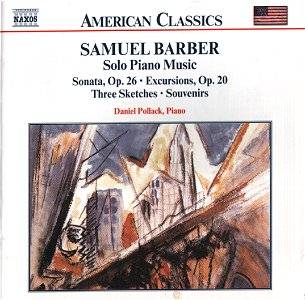
Piano Sonata (1949)
Excursions (1942-44)
Nocturne (1959)
Three Sketches (1923-24)
Interlude I (1931)
Ballade (1977)
Souvenirs (1952)
This is a generous collection and one without competition in the span of
works recorded. Of course the Sonata has been much recorded but to date the
above works have not been collected together on a single disc. Pollack (b.
1935) is fully the equal of the demands of this music. He has imagination,
delicacy and steel piston-stroke power in the sonata - a work I have never
really warmed to though the chill is lifted by some Rachmaninov-style romance
in the finale. No doubt he would find worthy comparison with Horowitz, Van
Cliburn and Joanna MacGregor in the Sonata but heard here one can hardly
imagine the sonata better presented. I was particularly taken with the power
of Pollack's rendering of the finale.
The Excursions veer between Boogie-Woogie, a Bluesy
Clair-de-Lune, a very lovely Allegretto of Latino-caste and
a fiddle and mouth-organ style Allegro molto. The brief Nocturne
is in homage to John Field. Interlude I (cloudy introspection)
is dedicated to fellow Curtis student, Jeanne Behrend. The Ballade's
restless depression (written reluctantly to a commission and heavy with the
depression that afflicted Barber in the late 1970s) is a work which seems
to inhabit the swampy reaches of some misty river - a work memorable for
its drooping note sequence. The Three Sketches: encompass a simple
love song in tempo di valse - a reticent and unconfident song it is
too; an even gentler essay dedicated to Barber's childhood Steinway and a
Minuet based on Beethoven's Minuet No. 2.
I am very partial to the orchestral version of Souvenirs written for
the ballet as late as 1952. It is a celebration of light music from around
the turn of the century. Its grandeur verges on the deliberately tawdry but
it is grandeur nonetheless and you can sample this to the full (short of
the orchestral version) in the Hesitation Tango - the climax of which
rains down thunder and stormy romance. This contrasts with a scatty two-step,
a jerky circus polka of a Schottische and a totally irresistible
Galop - all flickering, glinting, sparking lights. Good though Pollack
is I will still go for the orchestral version!
The excellent (English only) notes (by the Ledins - artistic consultants
to this admirable enterprise) represent a substantial essay on the composer's
piano music.
Recommended.
Reviewer
Rob Barnett

ROBERT RUSSELL BENNETT (1894-1981)
Abraham Lincoln Symphony (1929) [29.32] Sights and Sounds -
an orchestral entertainment (1929)
[22.56]  Moscow SO/William
T Stromberg Moscow SO/William
T Stromberg  NAXOS AMERICAN
CLASSICS 8.559004 [53.27] NAXOS AMERICAN
CLASSICS 8.559004 [53.27]
|
 |
Save around 22% with
Amazon
Crotchet |
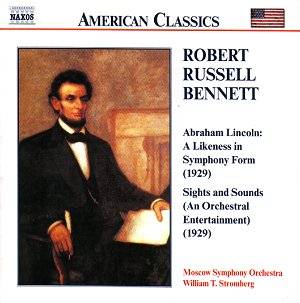
Bennett is best known as an orchestrator for shows and perhaps best of all
for his Symphonic Portrait of Gershwin's Porgy and Bess. His
success with shows secured his commercial future. However he was also busy
in the field of 'serious' composition.
Lincoln inspired many American works. The most exposed remains Copland's
Lincoln Portrait for orator and chorus but the roster of Lincolniana
is long and distinguished and the present symphony forms part of the orchestral
list:-
A Lincoln Legend MORTON GOULD
Lincoln - Requiem Aeternam HERBERT ELWELL
Lincoln's Gettysburg Address works by JOHN BECKER and FERDY
GROFÉ
Lincoln The Great Commoner CHARLES IVES
Symphony No. 10 Lincoln ROY HARRIS
Abraham Lincoln Walks at Midnight - works by EARL GEORGE, ROY HARRIS,
ELIE SIEGMEISTER
Abraham Lincoln Song WALTER DAMROSCH
Lincoln Address VINCENT PERSICHETTI
Lincoln (unfinished) JOHN KNOWLES PAINE
When Lilacs last in the dooryard bloom'd -
cantata SESSIONS
When Lilacs last in the dooryard bloom'd - requiem
HINDEMITH
(I would like to hear of other works on the theme of Lincoln)
Bennett wrote four numbered symphonies:-
No. 1 written in Europe (1926)
No. 2 Lincoln - A Likeness in Symphony Form (1929) premiered by Stokowski
No. 3 (1941) inspired by Baseball - The Dodgers
No. 4 (1963)
There is also an un-numbered Stephen Foster Symphony (1954) for chorus
and orchestra. This has been recorded on LP.
The symphony on this disc was written for the 1929 RCA Victor competition
judged by Stokowski, Olga Samaroff, Koussevitsky, Frederick Stock and Rudolph
Ganz. The munificent prize ($25,000) was split equally five ways: between
Copland's Dance Symphony, Bloch's Helvetia, Louis Gruenberg's
Symphony (remember Gruenberg's high power violin concerto recorded by Heifetz)
and the two works on this disc. Bennett had entered one serious work and
the other a much lighter work. Both won alongside the Bloch, Copland and
Gruenberg.
The Symphony is a work of serious and poetic spirit with much of the pugnacious
Northern poetry of Hanson's first two symphonies. Indeed Hanson seems to
have been something of an influence and certainly he supported Bennett's
works in concert performances throughout his life. This symphony is well
worthy of that devotion. The hoarsely throaty horns captured in forward splendour
in this recording are the coronets and laurels of this most rewarding recording.
The initial moderato ruffles musingly lyrical waters with fragments
of the belligerent Johnny Comes Marching Home. Apart from Hansonian
coups there are also some typical Roy Harris eruptions from the brass. The
second movement has a restive oboe song and some silky string playing as
well as a jaunty cavalry patrol at 2.00. The Allegro Animato (III)
has a flouncy dynamically glancing texture - a virtuosic helter-skelter of
slides, runs and wilderness hunting calls. The finale is characterised by
those grand, stabbing and abrasive horns in full flight and hunting clamour.
This is a most rewarding work well attuned to those who love their Hanson,
Roy Harris and Malcolm Arnold (anticipating his waspish exuberance and tense
lyricism by at least a decade) but with a twist and skew all its own.
The Sights and Sound suite - entitled an 'orchestral entertainment'
is the lighter of the two pieces. It is not however light in the Ferde
Grofé sense. It is more a dashing concerto for orchestra - a work
alive with the chaotic collage spirit of a child's colouring book. The work
bursts with impressions: poetic, popular, banal and catchy. It seems a natural
counterpart to the John Alden Carpenter works like Krazy Kat,
Skyscraper and Adventures in a Perambulator. A slightly jazzy
atmosphere crosses its pages but not suffocatingly so. The voices of people
like Stravinsky (Rite of Spring), Constant Lambert (Piano Concerto),
gamelan and Bartók are not far off and if some of these voices seem
advanced for the time the coating given to these influences is candy without
being saccharin. Nothing is tough to take on. As a series of contemporary
sketches it is more successful than George Lloyd's similarly themed 1960s
collage Charade. Another voice is that of Vaughan Williams and he
also glances out through the pages of the symphony. The fruity-chirpiness
of the sax at track 9 (0.35) in the Fox-Trot is a winner.
This piece is much better than the notes and the movement titles (Union
Station, Highbrows, Lowbrows, Electric Signs,
Night Club, Skyscraper, Speed) hint. This is
no Grofé or Coates-style novelty box of tricks … and I like both
composers, by the way.
Great notes by Bennett biographer George J Ferencz.
A valuable collection with plenty to enjoy. In fact, all in all, quite a
revelatory disc - a jewel in the Naxos crown. A CD that makes me want to
hear more Bennett. How about the other symphonies?
Reviewer
Rob Barnett

JOHN CAGE (1912-1992) Sonatas and
Interludes for prepared piano
(1946-48)  Boris
Berman (piano) Boris
Berman (piano)  NAXOS AMERICAN
CLASSICS 8.559042 [63:36] NAXOS AMERICAN
CLASSICS 8.559042 [63:36]
|
 |
Save around 22% with
Crotchet
Amazon |
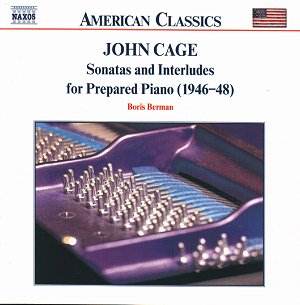
The piano is prepared …. but are we?
Mention the name of John Cage to most people even faintly 'in the know' and
the security shutters roll down. He, together with Stockhausen, Luigi Nono
and Bussotti, were the high priests of the avant-garde during the 1960s.
When, at long last, the 1970s signalled a return to a new accessibility his
music and that of many others began to take up the cellar and loft space
previously occupied by the music of Bax, Moeran, Piston and a host of other
fine tunesmiths.
Nowadays a much more catholic public is able, through the secure medium of
the CD (and no doubt other carriers in due course),to enjoy a very much wider
range of material while the record magazines (with the honourable exception
of Fanfare), radio stations and concert promoters become increasingly narrow
- mainstream classics, celebrity splurges, trendy commissions and little
else.
Now we can listen to Cage with a less prejudiced ear. What can he offer to
the adventurer? The style of these works is not that prickly. Much here is
extremely beautiful although the emphasis is on patterns of notes and silence
rather than melody. There are in fact sixteen sonatas and four interludes.
I will stand back from comment on individual tracks. The work seems to have
a reflective calmness as its axis. Much of the music is quiet - crepuscular
- suggesting ancient starry nights. Lights glint and a chilly glow fades
and comes again. The influence of gamelan seems obvious. I wonder if gamelan
ensembles were touring the States during the early 1940s? Anyone who has
heard the 78s of Britten and Colin McPhee playing the Gamelan Anklung
(Balinese Ceremonial Music) or knows the Britten ballet Prince
of the Pagodas will have some inkling of what to expect. The oriental
element here is not fake Chinoiserie (nothing of Ketèlbey or any one
of hundreds of purveyors) but conveys to this listener a mesmerised and mesmeric
absorption in mantras and time-suspending music. A similar approach was adopted
by Stockhausen in his Hymnus. Also it is not a far step onwards from
Cage to the minimalism of Steve Reich (Variations for orchestra) and
Philip Glass. The music has the wayward charm of an aleatory music box out
of control (no doubt some tautology there!).
If you enjoy the minimalists then do try this disc. If you have already come
across the entrancing prepared pianola music of Conlon Nancarrow (now there's
a project for you Naxos) try this. John Foulds' Essays in the Modes and
his orchestra; Three Mantras from Avatara also have some spiritual
kinship with this music.
As for the piano's preparation this is specified in the score and with some
precision: screws, bolts, bits of plastic and even a specific make of
india-rubber are all inserted at specific locations amongst the piano's strings.
The effect is one of Ariel-like witchery: Prospero's Island in deed.
Berman is a pianist I associated with the grand romantic manner. His sequence
of recordings from the 1970s and 1980s often centred on Rachmaninov. I was
not expecting him to weigh in on Cage's behalf.
David Revill's notes agreeably complete a package that would be fine at any
price but is commanding at this level.
Do not be put off by other people's prejudices. You will be surprised by
the whispered ice-crystal beauty of this music written in the stultifying
atmosphere of 1940s post-war USA. A very strong contender indeed and made
all the more significant by having Berman at the helm. There are no competitors
at this superbargain price range and very few at any price. I recall hearing
Roger Woodward's Headline Decca LP many years ago and there may be a Wergo
CD available but I would doubt that you will better Berman and Naxos's cleanly
engaging recording.
Reviewer
Rob Barnett

ZEZ CONFREY (1895-1971) Piano Music
 Eteri Andjaparidze
(piano) Eteri Andjaparidze
(piano)  NAXOS AMERICAN
CLASSICS 8.559016 [62:29] NAXOS AMERICAN
CLASSICS 8.559016 [62:29]
|
 |
Save around 22% with
Crotchet
Amazon |
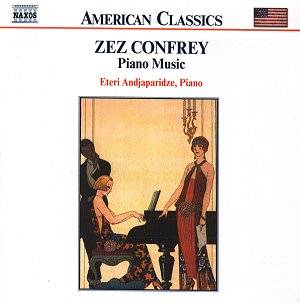
Kitten on the Keys 1921
Dizzy Fingers 1923
Meandering 1936
African Suite 1924
Jay Walk 1927
Sparkling Waters 1928
Wise Cracker Suite 1936
Amazonia 1945 |
Blue Tornado 1935
Three Little Oddities 1923
Coaxing the Piano 1922
Stumbling 1922
Moods of a New Yorker 1932
Rhythm Venture 1935
Fourth Dimension 1959 |
Zez Confrey was born Edward Eleazar Confrey in Peru, Illinois on 3 April
1895.
Confrey is the Transatlantic counterpart of Billy Mayerl. If you like Mayerl
you will certainly like this.
The famous Kitten is a celebration of scatty, jazzy, high speed
prestidigitation. Skimming pianism and impressively whispered dynamics are
memorable elements of Dizzy Fingers. Then comes the more reflective,
though still faintly jazzy, Meandering where pacing is plastic - with
many shifts and changes of gear.
The African Suite is not at all an evocation of the jungle: High Hattin
is a jazzy saunter, Kinda Careless a Gershwinian blues drone,
Mississippi Shivers is over-shadowed by the influence of Gershwin
but has something of the great river in it.
Jay Walk is a light-fingered wander; Sparkling Waters: a Lisztian
essay with silvery runs. Yokel Opus is light and easy; Mighty
Lackawanna is the first seriously impressionistic piece on the disc.
The surface of the piece is undisturbed and although a rippling pulse keeps
things mobile the atmosphere is placid. It glows in a heat haze. The Sheriff's
Lament is back to Confrey's accustomed Keystone Cops scattiness (just
as suggested by the liner notes).
Amazonia is initially only very slightly Latino despite the protestation
of the liner notes. There is a rhumba-Havanaise trill to the piece. Blue
Tornado again displays Confrey, the light as air prestidigitator. The
Impromptu from Three Little Oddities (and they each have a
salon-style title) is rather Ravelian and definitely the serious Confrey.
The notes suggest the influence of Grieg and Macdowell on these pieces and
that parallel is spot-on. The final Novelette is almost complicated
enough to be Medtner but stops well short of that most of the time.
Coaxing The Piano starts storm-goaded and soon settles into the hectic fists
of notes we know from Kitten on the Keys. The largely placid
Stumbling was much admired by Copland who wrote of it that it typified
the jazz age with its independent rhythms spread over more than one measure.
Moods of a New Yorker's At Dusk is a tentative exercise in half lights,
rather like some uncertain grey evening portrayed by Frank Bridge. Movie
Ballet reminds us of some Russian ballet, perhaps by Glazunov. Relaxation
is a tender golden dream (which I recommend as a sample track). The Tango
is slinky with a slippery reference to the Carmen 'Habañera'.
The Rhythm Venture is earnestly jazzy - an escapee from Constant Lambert's
Rio Grande. The Fourth Dimension jumps with electricity.
The Three Little Oddities and Moods of a New Yorker are much
more serious than Kitten on the Keys and Confrey's reputation might
hint. For anyone who thinks they might be allergic to 'home fires' piano
stool virtuosity try these two suites first. They are not desperately profound,
but no matter; this music entertains and delights.
Confrey would, I am sure, be delighted with Eteri Andjaparidze's zippy and
zestful performances which, in addition to their glitter, also articulate
the poetry of the pieces.
I suspect there will be a band of Confrey enthusiasts who will be buying
this disc in quantity. Quite how the performances stack up against Confrey's
own 78s I do not know. I had not heard Confrey's music until I put this disc
in the player. Now at least I know that Confrey has a place in the history
of music. It may not be a very exalted one but he is a composer who has genuine
humour, zest and feeling for people and place. A definite discovery.
The English only notes are by Marina and Victor Ledin. They are specific,
informative and generally add to the musical experience.
The treasure of a thousand thousand piano stools!
Recommended.
Reviewer
Rob Barnett

ARTHUR FOOTE (18.53-1937) Chamber
Music Vol. 1  James Barbagallo (piano) Da Vinci Quartet
James Barbagallo (piano) Da Vinci Quartet
 Lamont School of Music,
Denver, Colorado, 27-30 August, 11-14 December 1995 NAXOS AMERICAN CLASSICS
8.559009 [75.58] Lamont School of Music,
Denver, Colorado, 27-30 August, 11-14 December 1995 NAXOS AMERICAN CLASSICS
8.559009 [75.58]
|
 |
Save around 22% with
Crotchet
|
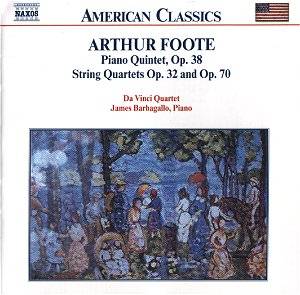
Piano Quintet (1897)
String Quartet No 2 (1893)
String Quartet No 3 (1911)
Foote is one of a number of classic American nineteenth century composers.
The Piano Quintet has a Brahmsian dash in the first movement while the
allegretto second movement is sheerly delightful in a Dvorákian
way. There is a whirlwind scherzo and then another Dvorákian movement
to round things off. The second quartet opens with an allegro giocoso
of eventide brilliance succeeded by a Mendelssohnian Scherzo,
some pleasing variations and a finale that harks back to the Bach double
violin concerto.
The third quartet is dedicated to Frederick Stock (who championed Foote's
work in Chicago) and although Dvorák is once again a presence in the
music there are many tart and unusual harmonies perhaps reaching outwards
towards the richness of the Franz Schmidt string quartets. The second movement
buzzes delicately but the third movement is rather conventional succeeded
by a finale of Janacekian lyricism.
Good music neglected for no reason other than laziness and a prejudice against
a home-grown product. In England we can view Foote through a range-finder
which (locally) also takes in Stanford and Parry.
Reviewer
Rob Barnett

ARTHUR FOOTE (18.53-1937) Chamber
Music Vol. 2  James Barbagallo (piano) Jeani Muhonen Foster (flute) Da Vinci
Quartet
James Barbagallo (piano) Jeani Muhonen Foster (flute) Da Vinci
Quartet Lamont School
of Music, Denver, Colorado, 27-30 August, 11-14 December 1995 NAXOS AMERICAN
CLASSICS 8.559014 [71.05] Lamont School
of Music, Denver, Colorado, 27-30 August, 11-14 December 1995 NAXOS AMERICAN
CLASSICS 8.559014 [71.05]
|
 |
Save around 22% with
Crotchet
Amazon |
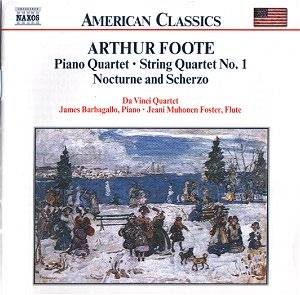
Piano Quartet (1890)
String Quartet No 1 (1883)
Nocturne and Scherzo for flute and string quartet (1918)
Barbagallo is much associated with the four Naxos volumes of Macdowell piano
music. The present recording is amongst Barbagallo's last recordings before
his tragically early death.
The Piano Quartet is a Brahmsian effusion of some élan dedicated to
John Knowles Paine ( a contemporary of similar reputation). The first movement
echoes with Mendelssohnian feather-down and the second's brilliance is out
of the pages of Mendelssohn's Octet for strings. The Adagio is all
Schubertian sweetness and reflective repose (Schubert's String Quintet).
Perhaps a tad overlong, it is followed by a bustling Allegro Non Troppo.
The 1883 String Quartet No. 1 is again Mendelssohnian - fresh, genuine and
with no hint of artifice. It is dedicated to the conductor Theodore Thomas.
The latest work in the two volumes is the Nocturne and Scherzo - a
work of sensuous delight rather in contrast to the golden age Teutonic
romanticism of many of these pieces. Its tart and chiming counterpoint is
quite original but a more conventional air settles on the scherzo with more
charming Mendelssohnian chatter.
Good notes and attractive unconsidered music.
Reviewer
Rob Barnett

CHARLES TOMLINSON GRIFFES (1884-1920)
Complete Piano Works Vol.
1  Michael Lewin
(piano) Michael Lewin
(piano)  rec 7-9 June
1995 Santa Rosa, California NAXOS AMERICAN CLASSICS 8.559023 [66.45] rec 7-9 June
1995 Santa Rosa, California NAXOS AMERICAN CLASSICS 8.559023 [66.45]
|
 |
Save around 22% with
Crotchet
Amazon |
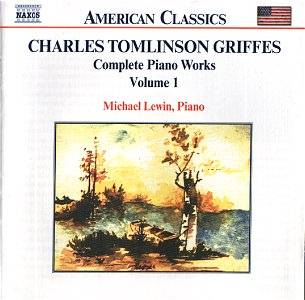
Piano Sonata (1919)
Three Tone Pictures (1910-1915)
De Profundis (1915)
Roman Sketches (1915-1916)
A Winter Landscape (1912)
Rhapsody in B minor (1912-14)
Barcarolle (1910)
Legend in F sharp minor (1915)
Prelude in B minor (1899-1900)
Griffes died young at the age of 38 He left behind him a handful of orchestral
works and a slightly larger reserve of songs and piano works. Many of these
piano solos receive their premiere recordings in this collection although
New World have had many of the major pieces in their catalogue for some years
now.
The piano sonata is a revolutionary piece. It broke the Brahmsian mould and
left behind no shred of Macdowell or Liszt. It is intoxicatingly revolutionary
invoking the name of Alexander Mossolov (piano sonatas 4 and 5) and even
Gershwin. Lewin plays to this avant-garde tendency and is not tempted to
soften the impact. Remarkable are the clanging landslides of notes in the
third movement oddly mixing Rachmaninov, John Cage and Nancarrow.
The Three Tone Pieces were orchestrated but the colours are almost
tangible in this performance. There are lapping waters in the first piece,
a darkling Poe-like vale in the second and clouds of insects and hailing
pebbles flood the sound-world of the final Night Winds.
The Roman Sketches comprise: The White Peacock (all exotic
plumage even in this barer piano solo version); Nightfall (brooding);
Fountains of Acqua Paola (surely this inspired Tarrega's Recuierdos
de la Alhambra) and the floating majesty of Clouds complete with
the wrong-note clangour of raindrops.
De profundis indulges in Wagnerian complexity. Winter Landscapes broods.
The Rhapsody rushes - honouring Brahms and Rachmaninov. The
Barcarolle is none other than a transcription of the silvery
Barcarolle from Offenbach's Tales of Hoffmann. The final
Prelude is Beethovenian and ordinary.
A fine collection and well worth acquiring at any price let alone bargain
price.
Reviewer
Rob Barnett

FERDE GROFÉ (1892-1972)
Mississippi Suite (1926) [13.35 ] Grand Canyon Suite
(1931) [32.00 ] Niagara Falls Suite (1961) [22.11]
 Bournemouth SO/William T Stromberg Bournemouth SO/William T Stromberg
 recorded Poole, 27-28
July 1998 NAXOS AMERICAN CLASSICS 8.559007 [67.45] recorded Poole, 27-28
July 1998 NAXOS AMERICAN CLASSICS 8.559007 [67.45]
|
 |
Save around 22% with
Crotchet
Amazon |
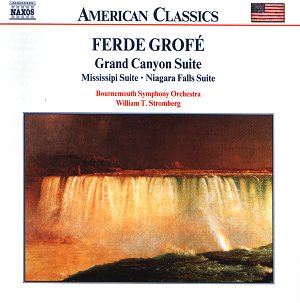
Grofé, if known to us at all, is best remembered as the orchestrator
of Gershwin's Rhapsody in Blue. Some may know him from the
Ormandy-conducted CBS version of the Grand Canyon Suite. As for
Grofé's music it is better described as picturesque rather than light.
These are musical postcards with an occasional and sometimes disconcerting
infusion of popular music.
The Mississippi Suite's Father of Waters is a slow, gentle,
warm, rocking, lilting sunrise interrupted by a marionettes' dance ... but
in iron shod boots. The Huck Finn second movement strolls along carefree
but the gross stupidity of Grofé's swanee whistles will grate with
many. The brass let rip with some fruity raspberries and all dissolves into
a Grand bamboula type dance. This is done with savage style by the Bournemouth
players. Old Creole Days is a slow and tender serenade for rocking
strings: lovely throughout and well worth extracting for CLASSIC FM in the
UK. Mardi Gras is the final movement with minstrel street corner songs
and dances and even a touch (or ten) of I Got Rhythm. We are treated
to a big swaying jazzy conclusion.
Sunrise from Grand Canyon Suite is announced by a drum roll, high
strings and bird song. The swooping woodwind aid a climax-building dawn-rise
of impassioned strings. The whole is wonderfully swung by Stromberg and the
movement escapes into a wild climax lit with sunburst grandeur. The Painted
Desert is rather reminiscent of Roussel's Evocations. The harp
accompanied music suggests the fountain sequence and serenade from Delius's
Hassan. On The Trail has a vaudeville climax that simply undermines
the suite. Composure is regained in the happy and contentedly Delian
Sunset. Finally Cloudburst brings things to an impressive pass
with strange tonalities bubbling up and piano roulades darting to the heights
and depths. I wonder if Britten heard this during his stay in USA. The Sea
Interludes from Grimes might well have had some debt to this piece.
A decade or so before his death Grofe wrote a Niagara Suite. The
Thunder Of Waters is grand but mixed in with the eddies and giant currents
are some red indian colours. The Devil's Hole Massacre is all gloom
and threat developing into a grand and imposing slaughterous uproar.
Honeymooners seems to look back to 1900s or even 1890s: all very demure
with little warmth or passion. Pot plants, hotel flunkies and gleaming marble.
A flat and tepid glass and the one disappointing movement among the three.
Charm and nothing else to sustain its 4:25. To end the whole disc Power
Of Niagara (the longest movement at almost ten minutes) takes us back
to the thunderous waters. It has something of Mossolov's Zavod or
Iron Foundry. The rushing overwhelming power and genuine convulsive
inspiration is well caught in accents which sound strangely Russian and even
give us the Varèse treatment with a howling siren and a riverboat
horn.
Great notes in scholarly and readable detail by series consultants Victor
and Marina A Ledin. These are in English, French and German. The cover art
is a painting of Niagara (18.57) by Frederic Edwin Church.
Warmly recommended for great performances of these picturesque though not
necessarily light pieces. They can be grouped more naturally with Delius's
Florida Suite than with Leroy Anderson's populist essays. The occasional
weird lapses and juxtapositions can be forgiven: they occupy less than 5%
of the playing time and as for the performances they are excellent.
Reviewer
Rob Barnett

VICTOR HERBERT (18.59-1924) Orchestral
Music from the Musicals Babes in Toyland The Red
Mill  Rasumovsky
Orchestra/Keith Brion Rasumovsky
Orchestra/Keith Brion  rec
Bratislava Sept 1996 NAXOS AMERICAN CLASSICS 8.559025 [56.50] rec
Bratislava Sept 1996 NAXOS AMERICAN CLASSICS 8.559025 [56.50]
|
 |
Save around 22% with
Crotchet
Amazon |
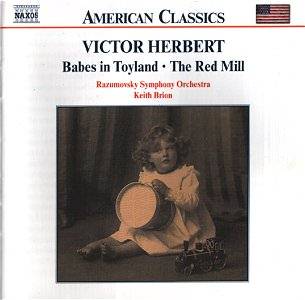
Victor Herbert's fame rests on his musicals. I note that a number of these
have been recorded complete over the last 20 years. The Naxos series has
done well to include a volume honouring one of America's (immigrant Irish)
most commercially successful sons.
The Babes in Toyland (1903) orchestral pot-pourri takes up three quarters
of an hour on this disc. This includes a very substantial (14 minute) prelude.
The music is a mix of early-Delian dreaminess (think of the Florida
Suite), salon charm, hints of popular music of the time, with helpings
of the lighter Berlioz and Tchaikovsky along the way. Oh, and don't forget
a shamrock leaf or two thrown in for effect. All is done with the smoothest
finesse. The Dancing Toymaker movement resorts, somewhat desperately,
to dog barks, duck squawks and rooster calls while The Red Mill (1906)
takes us into Strauss, Lanner, Millocker and Reznicek territory. The Red
Mill is an agreeable bag of candies: Coney island vulgarity, stertorous
marches, frilly bloomers, hour glass figures, straw boaters and striped
waistcoats - in fact all the panoply of Hollywood nostalgia. The music includes
a rather fine 'hesitation' dance.
Rather like the two Sousa discs in this series this would not be my chosen
listening fare (hence the star marking). Naxos and the artists here have
nevertheless done an excellent job. For those who are drawn to the lighter
Herbert and Sousa you are very unlikely to be able to do better than this
collection … and as with everything else in this series all at super-bargain
price. Reviewer
Rob Barnett

BENJAMIN LEES b. 1924 Symphony No
4 Memorial Candles (198.5)
 Kimball Wheeler (mezzo) James
Buswell (violin) National SO of the Ukraine/Theodore Kuchar Kimball Wheeler (mezzo) James
Buswell (violin) National SO of the Ukraine/Theodore Kuchar
 rec 15-19, 31 May 1998
NAXOS AMERICAN CLASSICS 8.559002 [61.42] rec 15-19, 31 May 1998
NAXOS AMERICAN CLASSICS 8.559002 [61.42]
|
 |
Save around 22% with
Crotchet
Amazon |
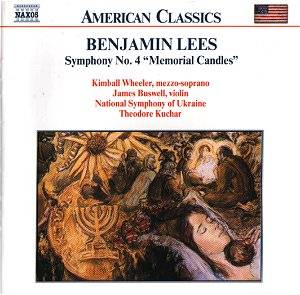
Benjamin Lees' is an American composer of Russian parentage. He was born
in China and came to the USA in 1925. He studied in California with Halsey
Stevens and Ingolf Dahl (ever heard Dahl's saxophone concerto?). He also
studied with George Antheil from 1949 to 1954.
He enjoyed some success and won various bursaries and scholarships, studying
in France and remaining in Europe for seven years. Lees received a UNESCO
award for his string quartet No 2 and the Bax Society Medal was awarded to
him in a surprise move - he was the first non-British composer to receive
the award.
His piano concerto No. 2 was played by Gary Graffman with the Boston SO under
Leinsdorf and in 1969 completed his third symphony. A trio of Bicentennial
commissions secured his reputation. The Dallas SO (much associated with his
teacher, Antheil) has commissioned three of his works. The present symphony
is the third.
The symphony commemorates the fortieth anniversary of the end of the Holocaust.
The work has a lofty grandeur redolent of Janacek, Shostakovich and even
the nobler moments of Copland's Lincoln Portrait. This is a nobility
battered by scorching sadness. Fanfares in spasm rend the land and after
five minutes the solo violin enters touching off music of virtuosic eloquence.
The movement ends in Shostakovich-like yelping.
The second movement's extended cello solo soon establishes a mood of lamentation
and bitter confidence. This articulate statement can be put alongside Martinu's
and Alan Bush's Lidice works and Britten's War Requiem. Lees
delivers a much closer emotional nexus than Britten. The roles taken by the
solo voice and solo violin wrest a skull-dark disquiet from the silence and
some of the music reminded me of Martinu's Gilgamesh.
The finale blends bird cries and sinister military manoeuvres. The Grimes
Sea Interludes seem to be a presence. The solo violin dances in worship
articulating inwardness and self-absorption. There are parallels in mood
with the Gorecki's Symphony of Sorrowful Songs though there is a tougher
spine in this work and a greater variety and foundation. The brass at the
close sound like the more climactic moments from Arthur Bliss's John Blow
Meditations.
The impressive solo violinist is James Buswell whom we last heard in the
Naxos coupling of the Piston violin concertos and before that in RVW's violin
Concerto for RCA/BMG with Previn and the LSO.
The notes by the composer and others have been extended by the American Classics
series producers Victor and Marina A Ledin. They are in English only and
provide full sung texts.
Altogether this is a document of tragedy in our times. It remains to be seen
whether it has staying power. For now it seems to be a work of enduring strength.
All this at bargain price.
Reviewer
Rob Barnett

EDWARD MACDOWELL (1860-1908) Piano
Music Vol. 1  James
Barbagallo (piano) James
Barbagallo (piano)  rec 14-18 May 1993, Novato, California NAXOS AMERICAN CLASSICS
8.559010 [63.49]
rec 14-18 May 1993, Novato, California NAXOS AMERICAN CLASSICS
8.559010 [63.49]
|
 |
Save around 22% with
Crotchet
Amazon |
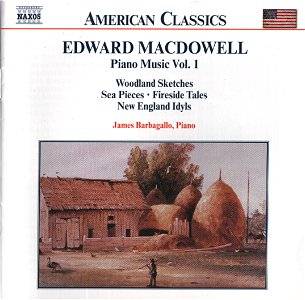
Woodland Sketches
Sea Pieces
Fireside Tales
New England Idylls
Barbagallo, now sadly passed away, was a man with a mission. Perhaps rather
like John Ogdon he delighted in supporting the neglected and worthwhile.
Many others have turned their back on Macdowell's 'simple charms' and consigned
him to what used to be a common fixture in every middle class house: the
piano stool.
His music is from the same firmament as Grieg and Schumann: a gentle romance
hangs over his music only buffeted with rougher winds in the sonatas. The
present collection avoids those cooler climes and concentrates on 34 character
pieces - all in just over an hour.
Charm, lyricism, reticence, honesty, and inspired affection are the hallmarks
of a Macdowell sketch. Some of the titles may remind us of Medtner but the
language is simpler. If the salon suggests itself as you listen to these
slender morsels it is at least a salon of higher aspiration rather than one
of maudlin narrow horizons.
The performances are bred of respect and affection in equal measure. The
Haunted House might be an opportunity for goblins of the psyche but if
it is darker than the rest it is only by the subtlest shading. There is a
brittle brightness in the final track Joy of Autumn. Sinding's rustling
leaves are perhaps not that far off but closer yet is the slender romance
of Grieg's Last Spring in this collection of drift and unpretentious
romance.
Reviewer
Rob Barnett

EDWARD MACDOWELL (1860-1908) Piano
Music Vol. 2 James
Barbagallo (piano) James
Barbagallo (piano)  rec
2-5 May 1994, Santa Rosa, California NAXOS AMERICAN CLASSICS 8.559011
[59.59] rec
2-5 May 1994, Santa Rosa, California NAXOS AMERICAN CLASSICS 8.559011
[59.59]
|
 |
Save around 22% with
Crotchet
Amazon |
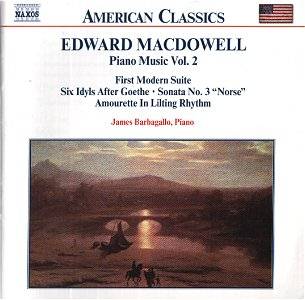
First Modern Suite
In Lilting Rhythm
Six Idylls After Goethe
Piano Sonata No. 3 Norse
The suite is a work of Lisztian tumult and display with Bach-like movements
and a slumbering Andantino straight out of the Liszt and Chopin piano
concertos. The finale ends busily in Bachian flight. There is an unassuming
Amourette (Op. 1!) and the Lilting Rhythm twins are lovingly
done without being terribly memorable. The Goethe Idylls are
unexceptionable, though typically well-rounded, little character sketches.
The Norse sonata is only 17 minutes long. It is dedicated to Grieg
and, not at all surprisingly, it is the Norwegian composer whose voice is
the dominant influence. It dates from 1900 and its opening Mesto is
broodingly dark. The central tristamente droops sadly while the finale
has a fiery jauntiness.
Recommended for Macdowell completists.
Reviewer
Rob Barnett

EDWARD MACDOWELL (1860-1908) Piano
Music Vol. 3 James
Barbagallo (piano) James
Barbagallo (piano)  recorded August 1994 NAXOS AMERICAN CLASSICS 8.559019 [64:56]
recorded August 1994 NAXOS AMERICAN CLASSICS 8.559019 [64:56]
|
 |
Save around 22% with
Crotchet
Amazon |
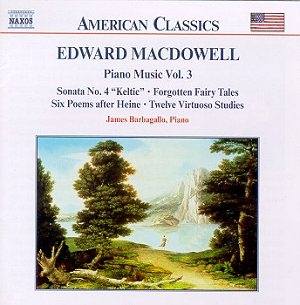
Sonata No. 4 Keltic (1901)
Forgotten Fairy Tales (1897)
Six Heine Poems (1887)
Twelve Virtuoso Studies (1894)
The grandissimo Keltic Sonata's flourishes strike up and down the
scale. Heroically impressive in Brahmsian dress its grandeur is diffused
by a spoonful or two of sentimentality in the middle movement but the finale
is resplendently resounding. The whole is well worth hearing but neither
especially Celtic nor distinctively American in any way I can detect.
The Forgotten Fairy Tales sound from the title to be a Medtnerian
sequence. Far from it. these are accomplished, charming, non-threatening
and ultimately tame children's stories. Yes, all charm, but done in aristocratic
style. A Victorian Disney approach to fairytales that are often darker
and more dangerous than they are given credit for.
The six pieces in the Heine set are poetically Brahmsian often radiating
an antique joy. The Postwagon borrows some Rossinian mountain pastoralism
from Guglielmo Tell. The Shepherd Boy reminded me fleetingly
of Saint-Saens' (2nd piano concerto).
The Twelve Virtuoso Studies are remarkable for their lively spirit.
There is a demented butterfly of a Moto Perpetuo, a Mendelssohnian
Wilde Jagd, the starry flight of Elfentanz and the cool Brahmsian
fever of Märzwind. The Impromptu is much indebted to Chopin
and the final Polonaise melds elements of Chopin with some watery
pre-echoes of Medtner in the grand manner.
The cover art uses a landscape painting by Washington Allston as does volume
4. The notes are by the Ledins who are the American Classics Series producers
and consultants to Naxos.
Recommended in the same spirit as the other volumes.
Reviewer
Rob Barnett

EDWARD MACDOWELL (1860-1908) Piano
Music Vol. 4 James
Barbagallo (piano) James
Barbagallo (piano)  recorded August 1994 NAXOS AMERICAN CLASSICS 8.559030 [55:27]
recorded August 1994 NAXOS AMERICAN CLASSICS 8.559030 [55:27]
|
 |
Save around 22% with
Crotchet
Amazon |
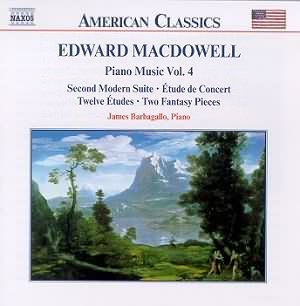
Etude de Concert
Second Modern suite
Serenata
Two Fantasy Pieces
Twelve Etudes
Perhaps because his piano music was taken to the heart of so many players
and straight into their piano stools Macdowell has had a reputation as a
pedlar of charming miniatures written to skill levels attainable by the domestic
players of the period 1880-1920. As this disc demonstrates emphatically his
music is worth much more. He is at least as adept and fresh as Grieg and
Saint-Saens at their best.
Etude de Concert (1889) storms with Lisztian bravura and Barbagallo is sheerly
wonderful. The playful and varied exuberance of the Second Modern Suite
is well illustrated by its final Phantasie-Tanz. Macdowell is
a composer of great eloquence and no arrogance. In some of his pieces he
aspired toward Celtic regions but it required a wilder palette than his to
mine that area deeply. After the brief charm of the Serenata we get
two meaty fantasy pieces the first of which is an item of the sheerest loveliness
and its partner is worthy of Saint-Saens - all wedding cake icing. The
Hexentanz has no horror - being more Mendelssohnian. The final sequence
of Twelve Virtuoso Studies are brilliant with an outstanding Hunting
Song and Tarantella. The wild Dance Of The Gnomes is a
veritable whirlwind.
There is a great deal of enlivening quick music on this disc and both the
anthology and the Etudes end with a Hungarian presto. Vivid
music making for Macdowell fanciers or for those who are curious and who
already warm to Liszt and Saint-Saens.
I have no criticism of the playing which is presented with the secure passion
of a great player who cares about the music he is advocating. What a tragedy
that Barbagallo died before he could complete the cycle of sonatas. As it
is he left us with only No. 4 (which is reviewed separately)
Notes (English only) by Victor and Marina A Ledin. These are beyond blemish.
Reviewer
Rob Barnett

EDWARD MACDOWELL (1860-1908) The
Complete Songs
(1889-1902) Steven
Tharp (tenor) James Barbagallo (piano) Steven
Tharp (tenor) James Barbagallo (piano)
 rec 1-3 August 1995,
Santa Rosa, California NAXOS AMERICAN CLASSICS 8.559032 [6836] rec 1-3 August 1995,
Santa Rosa, California NAXOS AMERICAN CLASSICS 8.559032 [6836]
|
 |
Save around 22% with
Crotchet
Amazon |
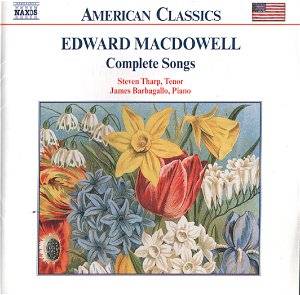
Macdowell's forty-two songs are presented in a CD running almost nine minutes
over the hour. Their style is one of unsurprising charm and again it is Schumann
and Grieg who must be our stylistic reference points. Tharp has a lovely
voice for which I must register high praise. His articulation is good and
of course he is partnered by the most sympathetic of pianists. The texts
are variously in English and German. This disc had me recalling the Schumann
LP collection recorded by Classics For Pleasure back in the late 1970s. This
consisted of songs sung in English by that past-master tenor, Ian Partridge,
accompanied by his sister Jennifer. It seems unlikely that the Tharp set
will ever have any competition. Given the excellence achieved in this garland
of fragile blooms there seems little point in others trying.
Reviewer
Rob Barnett

Return to [Part 1]
[Part 2]
[American Naxos part 2]
[January Index]
 COMPETITION:
WIN a CD
COMPETITION:
WIN a CD
 |
Search the Crotchet database from here |
All our reviews also appear
at |
Discs
on these pages are offered for sale. There is also a page of search
engines from a selection of on-line retailers
here.
Please support this web-site by buying
your discs here.
Disclaimer: Every effort is made to
make sales links to the correct disc but, in the end, you must take
responsibility for checking that what you are purchasing is what you want.
Some of these discs were not actually available for sale at the time of
posting but a link has been made in anticipation of their forthcoming
availablility.
Any opinions expressed in reviews or articles
on this site are those of the author and do not necessarily represent
the views of the site owner, Len Mullenger or the Editors. Reviewers
and authors retain copyright in their work unless it has been paid for or
commissioned by the site owner.
All prices, special offers etc relate to
the month of publication only or as
stated. |
Return to Index of Classical Reviews
